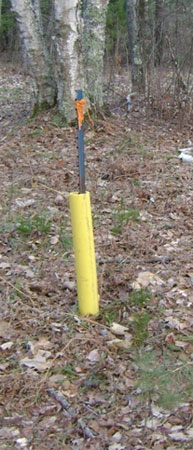Knowing the exact location of your property boundaries and corners can help to resolve disputes with your neighbors.
I was visiting with my brother-in-law at their property recently, when we got on the topic of property boundaries. It seems that he suspected his neighbor of moving a barbed wire fence that sat on the line between their properties. I had a feeling he was going to ask me to verify the position of the property line, so I quickly asked him if he had talked with his neighbor about it. Like many folks who own wooded property, he hadn’t.
He had talked with his neighbor on occasion when they first bought the property, but that was many years ago and now they just see each other from their tree stands during hunting season. Not an unusual situation for landowners in the region, but one that often leads to miscommunication and animosity.
I tried to convince him that discussing the location of the property line with his neighbor would be a good start to resolving the fence issue. Now, I am not saying his neighbor knows where the line and corners are. In fact, unless he had a survey done very recently, he wouldn’t know exactly where the line is either. By having the conversation, at least each one knows where the other thinks the line is. Additionally, the conversation could be an opportunity to find any property corners together and any monuments associated with the corners. Previously conducted surveys are usually available at county clerk offices, and their descriptions will help locate any monuments on the property.
If after all of that there still is grave disagreement, then they need to take some kind of action to resolve the situation. A forester can provide a pretty good estimate as to where the property line is, but if the situation is volatile it is probably time to bring in a surveyor.
Like any other contractor you may hire to do some work on your property, it is good to be in close communication with your surveyor. A surveyor will verify the accuracy of your title, and locate and mark corners on your property. In many states, only a surveyor can legally tamper with or set boundary markers. A surveyor may not necessarily mark boundary lines on your property unless you make an arrangement with them to do so.
If you have the time and gumption (and the surveyor is OK with it), tag along with the surveyor and document all of the moves they make with notes and photos. That includes identifying trees on your property, trees on your neighbor’s property, and those that fall right on the line. This information is especially important if you want to avoid charges of timber theft during any future timber sales.
Timber theft is a serious offense and one that can be avoided if you communicate your plans to your neighbor. Along with clearing up whose trees are whose, a discussion on harvesting plans could help to resolve issues surrounding access and trail location, and identify opportunities to work together to meet both of your goals.
After our conversation, my brother-in-law had a course of action to at least get some answers and possibly some resolution. He wasn’t too excited about having those conversations with his neighbor, but saw the value in at least keeping some kind of communication going.
